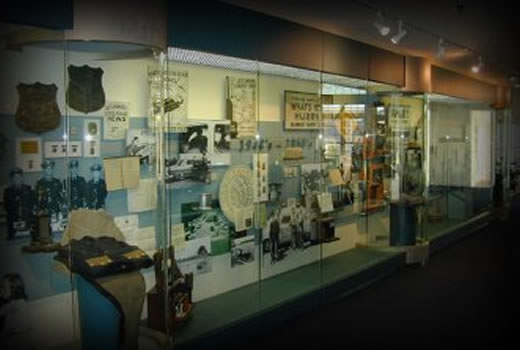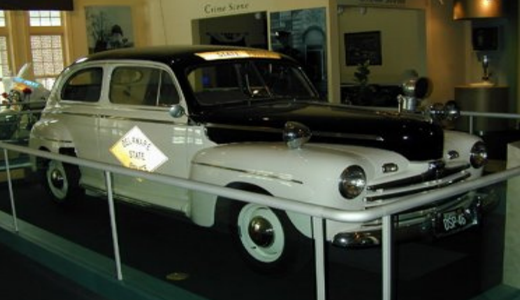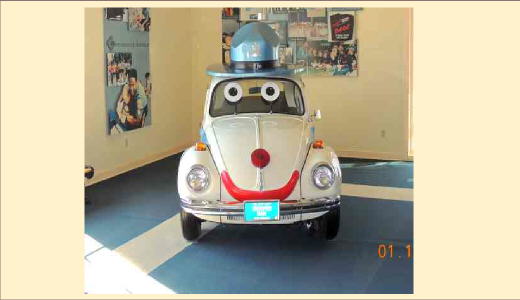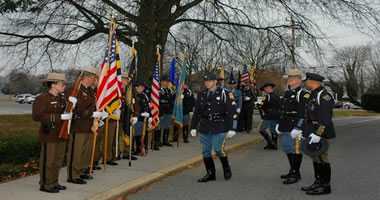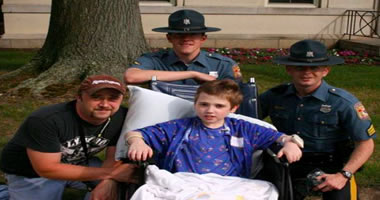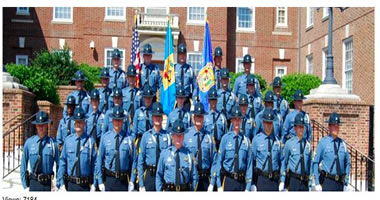History of the Delaware State Police - 1970-1974

The Division reached several milestones during the decade as a result of technological advances which would improve the existing communications system and link its criminal history database with those of other police agencies in the United States. In an attempt to address the serious problems of crime, drug use and highway deaths which were occurring in the state, a number of new programs and specialized units were created. The Delaware State Police would take steps toward the recruitment and hiring of female and minority applicants in order to fairly represent the population of the First State in its ranks.
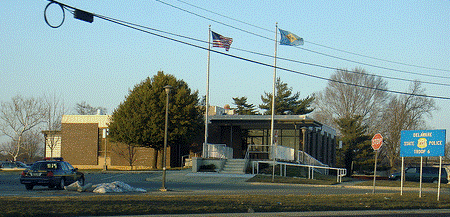 During the 1970's, the Division experienced an explosion of growth in a number of areas. One particularly prominent area of change was the construction of new facilities and the renovation of those currently in existence. In April of 1970, ground was broken on the new Troop 6 building located at Price's Corner near the old New Castle County Workhouse. The building was a modern two level brick construction of approximately 8,000 square feet, and was completed February 5, 1971.
During the 1970's, the Division experienced an explosion of growth in a number of areas. One particularly prominent area of change was the construction of new facilities and the renovation of those currently in existence. In April of 1970, ground was broken on the new Troop 6 building located at Price's Corner near the old New Castle County Workhouse. The building was a modern two level brick construction of approximately 8,000 square feet, and was completed February 5, 1971.

In the fall of 1970, Troop 7 in Dewey Beach became fully operational on a year round basis. Renovations were made to convert the former summer home into a fully staffed troop capable of operating on a 24 hour basis throughout the year.
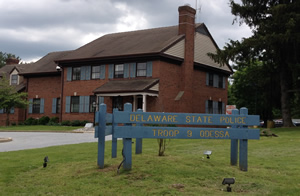 Just three years later in February of 1973, the new Troop 9 was dedicated by Governor Peterson. The building was designed to match the early American architecture of other buildings in the historical town of Odessa. Troop 9 housed 23 patrol units and members of the Auto Theft Unit and was responsible for providing police services in New Castle County from the Chesapeake and Delaware Canal to Smyrna. The cost for construction of the building and garage was $484,527.
Just three years later in February of 1973, the new Troop 9 was dedicated by Governor Peterson. The building was designed to match the early American architecture of other buildings in the historical town of Odessa. Troop 9 housed 23 patrol units and members of the Auto Theft Unit and was responsible for providing police services in New Castle County from the Chesapeake and Delaware Canal to Smyrna. The cost for construction of the building and garage was $484,527.

Several manpower reallocations were made during this era in order to increase the efficiency of the division's operations. In the early part of the 1970's, the newly established drug unit was moved from its office at Troop 2 to the "Ferry Boat". The New Castle County Communications Center was moved during this same period from its former location at Troop 8 near the turnpike toll plaza to a newly remodeled office at Troop 2 on State Road.
Technological progress also played a key role in the evolution of policing in Delaware during the 1970's. Advancements were made in virtually all areas from the collection and dissemination of criminal history information to communications and the latest advances in traffic enforcement.
 In May of 1970, a new crime reporting system was implemented statewide. This represented the first change in the established methods by which the state police had captured this information since the 1920's. The new system would reduce the time it took troopers to prepare a report in the field and would eventually evolve into the establishment of a fully automated information system on crimes in Delaware.
In May of 1970, a new crime reporting system was implemented statewide. This represented the first change in the established methods by which the state police had captured this information since the 1920's. The new system would reduce the time it took troopers to prepare a report in the field and would eventually evolve into the establishment of a fully automated information system on crimes in Delaware.
In 1971, the division purchased thirty VASCAR units for patrol cars. The 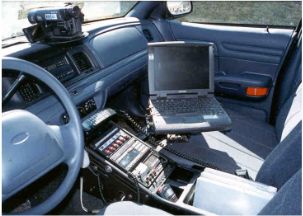 units were designed to increase the efficiency of troopers patrolling the highways. The computer calculated the speed of the violator by determining the time it took his vehicle to travel over a known distance. By the year's end, forty troopers were trained to use the VASCAR units which resulted in 287 arrests. In 1972, the first VASCAR case was successfully tried in Kent County Superior Court, establishing legal acceptance of the technology in the state.
units were designed to increase the efficiency of troopers patrolling the highways. The computer calculated the speed of the violator by determining the time it took his vehicle to travel over a known distance. By the year's end, forty troopers were trained to use the VASCAR units which resulted in 287 arrests. In 1972, the first VASCAR case was successfully tried in Kent County Superior Court, establishing legal acceptance of the technology in the state.
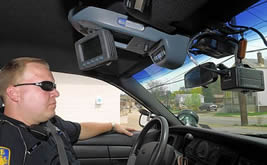 A video tape camera was purchased by the state police for the detection and prosecution of DUI violators. The $23,000 system was funded in part by the Delaware Agency to Reduce Crime and was primarily used during the questioning of a drunken driver in order to provide defense attorneys with strong visual evidence of their client's impairment. Eventually, six of the nine state police troops were equipped with the video equipment.
A video tape camera was purchased by the state police for the detection and prosecution of DUI violators. The $23,000 system was funded in part by the Delaware Agency to Reduce Crime and was primarily used during the questioning of a drunken driver in order to provide defense attorneys with strong visual evidence of their client's impairment. Eventually, six of the nine state police troops were equipped with the video equipment.
 Several major advances in the area of radio communications occurred during the decade as new police protection zones became operational in New Castle County with the installation of a new system designed to speed up telephone calls for police service. The heart of the system was a matched pair of switchboards, one at New Castle County Police Headquarters and one at Troop 2 on State Road. Both communications centers were equipped with radio hookups so they could monitor one another's calls.
Several major advances in the area of radio communications occurred during the decade as new police protection zones became operational in New Castle County with the installation of a new system designed to speed up telephone calls for police service. The heart of the system was a matched pair of switchboards, one at New Castle County Police Headquarters and one at Troop 2 on State Road. Both communications centers were equipped with radio hookups so they could monitor one another's calls.
In 1974, automatic recording equipment was installed in each communications center. The equipment had the capability of recording up to twenty radio and telephone circuits simultaneously and insured the accurate documentation of information concerning calls for police service. In addition, twenty high band radios were installed in patrol vehicles and radio frequencies were changed to allow police to operate on either the low or high band frequency.
During the decade troopers received a substantial pay increase and, for the first time, elected to be represented in contract negotiations by a specific collective bargaining unit. In addition, a major governmental restructuring would take place in order to increase the efficiency of the division and better meet the needs of the citizens.
In January of 1970, Governor Peterson and the State Highway Department asked the General Assembly for an across the board pay increase of 7.5%. The new pay ranges were retroactive to January 1 and provided 7 step increases in pay for each rank.
- Trooper ...................... $7,310.00 - $10,285.00
- Trooper 1st class ............ $7,950.00 - $10,655.00
- Detective/Corporal ........... $8,600.00 - $11,525.00
- Sergeant ..................... $9,245.00 - $12,385.00
- Lieutenant ................... $9,675 - $12,960
- Captain ...................... $10,320 - $13,805
- Staff Captain ................ $10,645 - $14,265
- Major ........................ $13,115 - $17,570
The highway department also approved special duty pay for troopers for jobs which were "police-related, of service to the general public, and approved by the superintendent".
 On March 18, 1970, Senate Bill 442 established a Department of Public Safety incorporating the State Police and Motor Vehicle functions of the old State Highway Department with the responsibilities of civil defense and boiler safety. This governmental restructuring placed the Delaware State Police under the auspices of the Director of Public Safety. The bill also established within the department a division of Intergovernmental services which included state communications. On May 19, 1970, retired Brigadier General Fred W. Vetter was appointed the first Director of Public Safety in Delaware by Governor Peterson.
On March 18, 1970, Senate Bill 442 established a Department of Public Safety incorporating the State Police and Motor Vehicle functions of the old State Highway Department with the responsibilities of civil defense and boiler safety. This governmental restructuring placed the Delaware State Police under the auspices of the Director of Public Safety. The bill also established within the department a division of Intergovernmental services which included state communications. On May 19, 1970, retired Brigadier General Fred W. Vetter was appointed the first Director of Public Safety in Delaware by Governor Peterson.
In February of 1973, state police FOP Lodge #6 was selected to represent troopers in negotiations with the Public Safety Department. This was the first time that the members of the state police had elected to be represented by a specific collective bargaining unit.
On April 17, 1973, a new jurisdictional agreement was signed by the Director of Public Safety and the New Castle County Executive. The agreement stated that the Delaware State Police would be responsible for the investigation of criminal offenses which occurred in commercial areas and for traffic related services which occurred on major highways in the county. The New Castle County Police were given primary jurisdiction over crimes and traffic services which occurred in residential areas.
The division lost five of its members during the decade, including the second and third members of the division to be shot and killed in the performance of their duties.
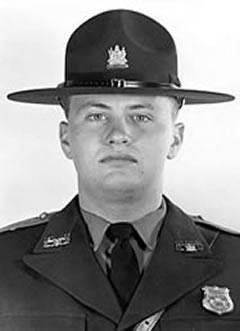
![]()
Trooper William C. Keller, a member of the drug control unit, was killed January 22, 1971, in a two vehicle crash at Tybouts Corner on US 13. Trooper Keller was reporting for an assignment in the Dover area when the collision occurred. He was driving south on US 13 in an undercover vehicle when a garbage truck pulled into his path. Trooper Keller was pronounced dead on arrival at Delaware Division in Wilmington.
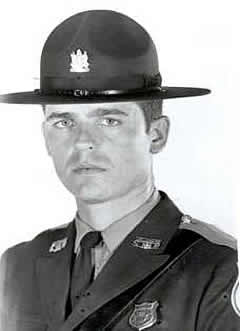
![]() Troopers Ronald L. Carey and David C. Yarrington were killed in the line of duty
Troopers Ronald L. Carey and David C. Yarrington were killed in the line of duty while investigating an armed robbery which had occurred at the Tally Ho Motor Lodge on January 5,
![]() 1972. The troopers were checking the Concord Motel for the suspects and, upon observing a car with its motor running in the parking lot, proceeded to investigate. The troopers apparently confronted Irving Hogg, a convicted felon from Ohio, and his female accomplice, Marylyn Dobrelinski. While Troopers Carey and Yarrington scuffled with Hogg, Dobrolenski shot both officers. The suspects led police on a 14 hour manhunt which ended when a Maryland Trooper shot and killed Hogg during a high speed chase. Dobrolenski was apprehended in a Maryland bean field following the pursuit. Trooper Carey was pronounced dead on arrival at Delaware Division at 3 am on January 5th. Trooper Yarrington died at the same hospital at 2:20 am on the following morning. On June 27, 1972, Dobrolenski was sentenced to die in Pennsylvania's electric chair for the slayings of Troopers Carey and Yarrington, but her sentence was later commuted to life in prison by the Pennsylvania Supreme Court.
1972. The troopers were checking the Concord Motel for the suspects and, upon observing a car with its motor running in the parking lot, proceeded to investigate. The troopers apparently confronted Irving Hogg, a convicted felon from Ohio, and his female accomplice, Marylyn Dobrelinski. While Troopers Carey and Yarrington scuffled with Hogg, Dobrolenski shot both officers. The suspects led police on a 14 hour manhunt which ended when a Maryland Trooper shot and killed Hogg during a high speed chase. Dobrolenski was apprehended in a Maryland bean field following the pursuit. Trooper Carey was pronounced dead on arrival at Delaware Division at 3 am on January 5th. Trooper Yarrington died at the same hospital at 2:20 am on the following morning. On June 27, 1972, Dobrolenski was sentenced to die in Pennsylvania's electric chair for the slayings of Troopers Carey and Yarrington, but her sentence was later commuted to life in prison by the Pennsylvania Supreme Court.
![]()
Trooper George W. Emory was killed in an auto accident while returning home from duty at 11:45 pm on June 2, 1972. Emory was returning home after working the 3 to 11 shift at Troop 3 when his car was struck from behind by a vehicle which was speeding southbound on US Route 13 near Harrington. Trooper Emory was pronounced dead on arrival at Milford Memorial Hospital at 12:01 am. Trooper Emory was buried in the Cemetery at Saint Luke's Church in Seaford.
Several new programs were born as the division continued to move toward specialization in an attempt to address problems which were of growing concern during the period. Many of the special units which were formed during this era are still in existence today in some form; a testament to their effectiveness over the years.
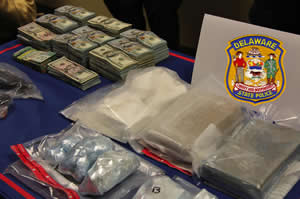 As a direct result of the increasing drug problem within the state, a full time drug unit was established within the Criminal Investigation Division on January 22, 1970. The unit was made up of seven undercover troopers and was responsible for the prevention and detection of drug related offenses. The unit originally worked out of offices at Troop 2 on State Road, but later that year moved into the old Troop 2 building which was known by the nickname, "the Ferry Boat." Within its first nine weeks of operation, the unit was credited with arresting 53 persons on 69 drug related offenses.
As a direct result of the increasing drug problem within the state, a full time drug unit was established within the Criminal Investigation Division on January 22, 1970. The unit was made up of seven undercover troopers and was responsible for the prevention and detection of drug related offenses. The unit originally worked out of offices at Troop 2 on State Road, but later that year moved into the old Troop 2 building which was known by the nickname, "the Ferry Boat." Within its first nine weeks of operation, the unit was credited with arresting 53 persons on 69 drug related offenses.
 In May of 1971, an Auto Theft Unit was established to curtail the activities of car theft and salvage rings which had set up operations within the state. In its first eight months of operation, the Auto Theft Unit checked over 21,000 vehicles and recovered 27 stolen cars and parts with an estimated street value of $54,430.
In May of 1971, an Auto Theft Unit was established to curtail the activities of car theft and salvage rings which had set up operations within the state. In its first eight months of operation, the Auto Theft Unit checked over 21,000 vehicles and recovered 27 stolen cars and parts with an estimated street value of $54,430.
In 1972, the Central Organized Crime Unit was established under a twelve month grant. The unit was primarily responsible for the gathering and dissemination of intelligence concerning statewide organized criminal activities.
 In June of 1974, a statewide unit was formed to target illegal drug distribution and sales in Delaware. The unit was formed in response to a rapid rise in heroin sales and the increased mobility of drug dealers. It was comprised of officers from Wilmington PD, New Castle County PD, and the Delaware State Police. In addition, the cities of Milford, Seaford, Dover and Rehoboth provided one officer each for assignment to the unit.
In June of 1974, a statewide unit was formed to target illegal drug distribution and sales in Delaware. The unit was formed in response to a rapid rise in heroin sales and the increased mobility of drug dealers. It was comprised of officers from Wilmington PD, New Castle County PD, and the Delaware State Police. In addition, the cities of Milford, Seaford, Dover and Rehoboth provided one officer each for assignment to the unit.
 The Division continued its support of young people in the First State by implementing a number of innovative programs. In 1970, the Delaware State Police Youth Activities Program was formed. Initially, the program consisted of two trooper coached basketball teams playing in the Salvation Army Leagues. In four years, the program grew to eighteen teams playing in three area high school gyms in New Castle County and fostered lasting relationships between the youths involved and their trooper coaches.
The Division continued its support of young people in the First State by implementing a number of innovative programs. In 1970, the Delaware State Police Youth Activities Program was formed. Initially, the program consisted of two trooper coached basketball teams playing in the Salvation Army Leagues. In four years, the program grew to eighteen teams playing in three area high school gyms in New Castle County and fostered lasting relationships between the youths involved and their trooper coaches.
In July of 1972, the first annual Trooper Youth Week was held at the Delaware State Police training academy. The program served high school students between the ages of 16 and 18 and represented twenty schools from throughout the state. The youths ate, slept, participated in physical training and attended classes at the academy like actual recruit troopers. Trooper Youth Week still continues today, providing Delaware students with a unique opportunity to experience some of the education and training requirements which must be met in order to pursue a career in law enforcement.

In 1974, the state police reconditioned a 1971 Volkswagen for use in highway and bicycle safety programs designed for younger children throughout the state. The car, named, "Trooper Dan", sported a white paint job complete with chevrons on the front fenders and state seals on the doors. The VW Beetle was topped off with a huge blue campaign hat and had moving "eyes" attached to its windshield wipers. Troopers were able to make Trooper Dan "talk" with children while standing over 100 feet away from the vehicle through use of a portable short wave radio control board.
On February 17, 1970, the United States Department of Transportation awarded a $137,450 grant to the Delaware Highway Safety  Coordinator's Office for the intended purchase of a helicopter and pilot training. This marked the creation of the Delaware State Police Aviation Section which exists today, as five troopers were transferred into the unit for full time duty. The new helicopter would be used for the transport of injured persons from accident scenes and for aerial patrol of the highways. The pilots were trained at an eight week school in Trenton, New Jersey, in November of 1970, and a Bell Jet Ranger Helicopter was ordered from Atlantic Aviation Corporation in Wilmington at a cost of $149,760. The Bell Jet Ranger completed its first mission in February of 1971, when it located and saved three men adrift in the Delaware Bay. In 1974, two more pilots were transferred into the Aviation Section for full time duty. The additional manpower would allow the unit to provide 16 hours of coverage, seven days per week.
Coordinator's Office for the intended purchase of a helicopter and pilot training. This marked the creation of the Delaware State Police Aviation Section which exists today, as five troopers were transferred into the unit for full time duty. The new helicopter would be used for the transport of injured persons from accident scenes and for aerial patrol of the highways. The pilots were trained at an eight week school in Trenton, New Jersey, in November of 1970, and a Bell Jet Ranger Helicopter was ordered from Atlantic Aviation Corporation in Wilmington at a cost of $149,760. The Bell Jet Ranger completed its first mission in February of 1971, when it located and saved three men adrift in the Delaware Bay. In 1974, two more pilots were transferred into the Aviation Section for full time duty. The additional manpower would allow the unit to provide 16 hours of coverage, seven days per week.

During the 1970's, the first take home car program was instituted on a statewide basis. The 100 marked patrol cars were assigned to corporals and below and were dispersed with consideration to the geographic areas where the troopers lived. This was particularly important to provide maximum police protection to the larger areas of Kent and Sussex County. The program allowed troopers to patrol an additional hour per shift on average since they were considered on duty as soon as they entered their patrol cars.
Issues of highway safety were also prominent during the 1970's, prompting the emergence of an array of new programs targeting speeders, 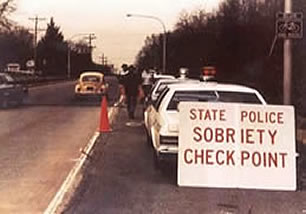 drunken driving and other violations in an attempt to reduce the ever increasing numbers of highway related fatalities occurring within the state. These programs, in conjunction with the national 55 mile per hour speed limit, were credited with substantially reducing the number of deaths occurring on Delaware highways. In one such program, four special enforcement units were assigned to combat highway traffic accidents through proactive measures. The three man units were equipped with RADAR and VASCAR systems and worked with the Delaware State Police helicopter and airplane in enforcing the state's speed laws.
drunken driving and other violations in an attempt to reduce the ever increasing numbers of highway related fatalities occurring within the state. These programs, in conjunction with the national 55 mile per hour speed limit, were credited with substantially reducing the number of deaths occurring on Delaware highways. In one such program, four special enforcement units were assigned to combat highway traffic accidents through proactive measures. The three man units were equipped with RADAR and VASCAR systems and worked with the Delaware State Police helicopter and airplane in enforcing the state's speed laws.
 In 1973, eight specially marked blue and white cars manned by officers from the state police, New Castle County Police, Wilmington City Police and Dover City Police began a federally funded patrol operation targeting drunken drivers within the state. The Alcohol Safety or ASAP teams patrolled five nights per week from 7 pm to 3 am and made routine checks of drivers who exhibited signs of alcohol impairment.
In 1973, eight specially marked blue and white cars manned by officers from the state police, New Castle County Police, Wilmington City Police and Dover City Police began a federally funded patrol operation targeting drunken drivers within the state. The Alcohol Safety or ASAP teams patrolled five nights per week from 7 pm to 3 am and made routine checks of drivers who exhibited signs of alcohol impairment.
In response to public complaints concerning violations involving heavy trucks, a three man truck enforcement team was formed in June of 1974, to enforce laws pertaining to trucks for the first time. The team would focus on violations of speed, weight, fuel and tax laws. Unit members were equipped with portable scales which allowed them to weigh trucks on the spot.
 Advances in training during the decade included the adoption of two new in-service training programs. In order to improve the working relationship between police officers in Delaware and members of the news media, in January of 1974, over 100 state troopers met with members of the news media at the Delaware State Police training academy for the first Police-Press Relations workshop held in Delaware. The workshop allowed participants to air their concerns and present ideas for improving communication between law enforcement and the news media in Delaware. A seventeen page handbook entitled Public Information Policy was distributed to newsmen attending the workshop. The same handbook was eventually distributed to every state policeman in Delaware.
Advances in training during the decade included the adoption of two new in-service training programs. In order to improve the working relationship between police officers in Delaware and members of the news media, in January of 1974, over 100 state troopers met with members of the news media at the Delaware State Police training academy for the first Police-Press Relations workshop held in Delaware. The workshop allowed participants to air their concerns and present ideas for improving communication between law enforcement and the news media in Delaware. A seventeen page handbook entitled Public Information Policy was distributed to newsmen attending the workshop. The same handbook was eventually distributed to every state policeman in Delaware.
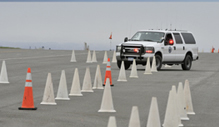
The same year the Safe Pursuit Emergency and Enforcement Driving program required state police recruits to spend twenty-four hours on the runway of the Sussex County Airport learning to handle a car under a variety of driving conditions. This was the first in service training program involving emergency vehicle operations.
The decade of the 1970's witnessed many changes in the requirements and qualifications which were expected of prospective applicants. More emphasis would be placed on education and the division would take steps toward the recruitment and selection of female and minority applicants. Beginning in May, 1970, the division required at least six credit hours in the area of behavioral science from an accredited college. The credits were required to be obtained within a two year period from the officer's date of hire.
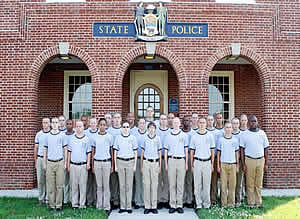 At the end of July, 1970, the first mandatory eight week training course for municipal recruits was conducted at the state police training academy. On February 14, 1972, classes started at the training academy for a combined class of 64 state, county and municipal recruits. Included in this class were five black recruit troopers. This was the first class in the academy which combined municipal and state police recruits. For the first ten weeks of training, all recruits lived and studied together. They wore identical khaki uniforms without departmental designation and shared work assignments on an alternating schedule.
At the end of July, 1970, the first mandatory eight week training course for municipal recruits was conducted at the state police training academy. On February 14, 1972, classes started at the training academy for a combined class of 64 state, county and municipal recruits. Included in this class were five black recruit troopers. This was the first class in the academy which combined municipal and state police recruits. For the first ten weeks of training, all recruits lived and studied together. They wore identical khaki uniforms without departmental designation and shared work assignments on an alternating schedule.
In 1973, women were welcomed to apply for the position of trooper for the first time. They were, however, forced to meet the minimum height standard of 5 feet 9, inches. Qualified female applicants  would also have to meet the same physical requirements as their male counterparts. The following year physical tests were modified and a new personnel office was formed. One of its primary purposes was to develop a recruiting program aimed at attracting women and other minorities. In an attempt to make the qualifications fair to female applicants, the old requirements which specified that a recruit must be able to hold a 100 pound weight over their head for ten seconds and perform three chin-ups were omitted. As a result, in 1976 Cynthia Lowden and Georgia Stevens Carter became the first female state troopers to graduate from the Delaware State Police training academy.
would also have to meet the same physical requirements as their male counterparts. The following year physical tests were modified and a new personnel office was formed. One of its primary purposes was to develop a recruiting program aimed at attracting women and other minorities. In an attempt to make the qualifications fair to female applicants, the old requirements which specified that a recruit must be able to hold a 100 pound weight over their head for ten seconds and perform three chin-ups were omitted. As a result, in 1976 Cynthia Lowden and Georgia Stevens Carter became the first female state troopers to graduate from the Delaware State Police training academy.

